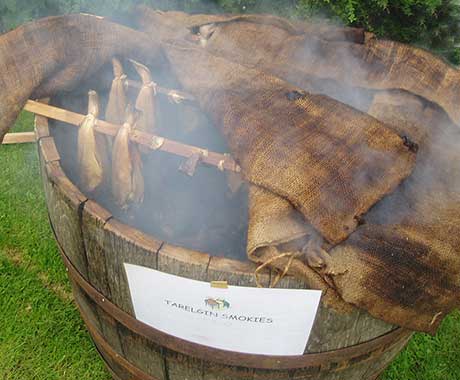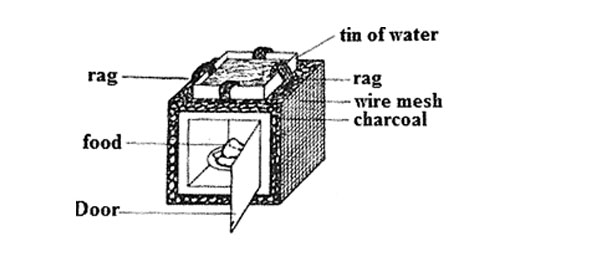- Food preservation means keeping food in its fresh form to avoid contamination or to ensure that it does not go bad.
- We usually preserve food when it is in excess to ensure that we use it at a later date.
eg drying pepper for later use.
- Food can be preserved in various ways.
- Some ways may be traditional while other ways are modern.
The traditional ways of food preservation are those methods that were used a long time ago by our forefathers, though some are still being used to date.
These methods are:
Smoking is mainly used to preserve fish and meat.
The meat to be preserved is hung high above a smoky fire until a hard outer layer is formed.
This crust of smoke forms the barrier that prevents the entry of micro-organisms that cause spoilage.
The layer or crust is also poisonous to the micro-organisms.
In most cases, the meat or fish is dried before smoking.
The fire to be used should be of low temperature.
Examples of foods that can be preserved by drying are meat, fish, maize, beans and peas.
The food is spread on animal skins or mats and left in the open air where it is exposed to heat from the sun.
The food has to be turned over so that it can dry evenly.
When food is dried, the water in the food is lost through evaporation.
Since the organisms that cause food spoilage need moisture to survive, the dried food becomes unsuitable for the survival of microorganisms.
Another advantage of drying in the sun is that radiation from the sun kills the microorganisms that are exposed to sunlight for long.
The foods that can be preserved by salting are meat and fish.
In this method, the food is sprinkled with salt.
Micro-organisms cannot grow in concentrated salt solutions.
Salt also kills the micro-organisms by draining water from them (dehydrating them).
Food that can be preserved using honey is meat.
The food is first cooked or roasted and then dipped into a container with honey.
The honey should cover all the parts of the food.
Honey contains a high concentration of sugar.
Most micro-organisms cannot grow or live in concentrated sugar.
The concentrated sugar dehydrates the micro-organisms.
Proper storage of food was essential even in the old days.
Foods are always kept in cool dry places to prevent them from getting moist.
Grains are kept in granaries that are cool and well ventilated.
The granaries also protect the food from getting wet.
Some communities preserved grains by mixing them with ash to keep away pests such as weevils and therefore guarding the grains from both waste and spoilage.
Modern methods of food preservation are those methods that are being used today.
The modern methods rely more on technology than the natural ways and natural products to preserve food.
Modern technology has introduced the use of electricity and chemicals.
The modern methods of preserving food are:
In modern smoking, the food (meat or fish) is cut into smaller pieces and then arranged on racks in specially built structures called smokehouses.
The food is then exposed to chemical treatment by coating the food with a layer of chemicals that are sprayed on to the food.

The food may be air-dried or dried in an oven until it loses water.
The heat in the oven kills the micro-organisms.
Once the food is dry, micro-organisms cannot grow in it.
Food such as meat, fruits, vegetables, milk, and other drinks are preserved at low temperature in refrigerators, freezers or cold storage rooms.
These use electricity to cool the food to very low temperatures
Canning means putting foods in cans or tins from which all air has been removed.
The can or tin is then tightly sealed or closed.
The can or tin, therefore, becomes airtight.
The sealed can or tin is then heated in boiling water or steam at high temperature for a while to kill the micro-organisms.
Standard 6
1. Small scale farmers store maize in granaries raised above the ground level. The main reason for raising the granaries above the ground level is to keep
A. The granaries clean B. Maize free from insect pests
C. Maize safe from thieves D. The granaries dry
2. Standard VIII class at Baridi Primary School made a solar cooler as shown by the diagram below.

When the door is closed, the food inside the cooler was cooled because
A. The water evaporates from the charcoal
B. The charcoal insulates the cooler
C. The charcoal reflects heat away
D. The water is colder than the surrounding
3. The purpose of charcoal in a charcoal cooler is to
A. Increase surface area B. Store water
C. Absorb heat rays D. Make the walls thicker
4. Salting helps in preserving fish by
A. Softening the fish B. Improving the taste of fish
C. Improving the colour of fish D. Removing water from the fish